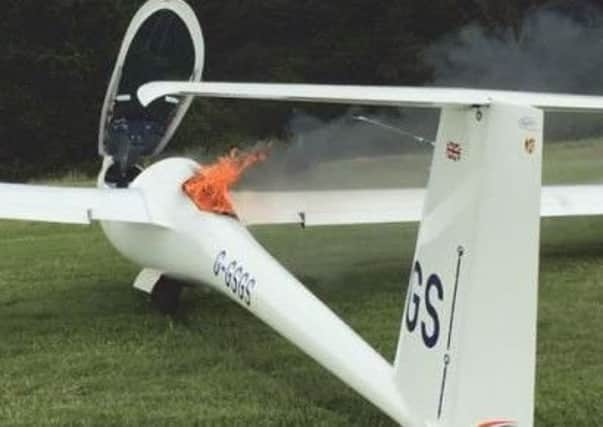Glider fire sparks investigators to consider new safety recommendations


On August 10, 2017, the glider sailplane set off from the airfield between Storrington and Pulborough at 10.21am for a flight lasting approximately two hours.
The glider was flown normally to a smooth touchdown, according to the AAIB, until the pilot heard an ‘unexpected noise’.
Advertisement
Hide AdAdvertisement
Hide AdThe AAIB report said: “As the glider slowed during the ground run, the pilot smelled burning and the cockpit filled with smoke that was moving forwards from behind the pilot’s head.
“He vacated the cockpit normally, without injury, and observed that the Front Electric Sustainer (FES) battery compartment cover was missing and that smoke, followed shortly by flames, was coming from the battery compartment.
“The airfield fire truck arrived promptly and an initial attempt was made to extinguish the fire using a CO2 gaseous extinguisher, but this proved unsuccessful.
“Aqueous film-forming foam (AFFF) was then sprayed into the FES battery compartment and the fire was extinguished.”
Advertisement
Hide AdAdvertisement
Hide AdThe pilot was the only person on board the glider, according to the AAIB.
He did not report observing any warning messages or illuminated LEDs, when asked by the AAIB, although his attention was drawn outside the cockpit during landing.
The AAIB report found existing FES battery installations ‘do not provide sufficient warning’ to a pilot of a fire.
As a result, the AAIB made a safety recommendation that ‘all powered sailplanes fitted with an FES system, must be equipped with a warning system to alert the pilot to the presence of a fire in the FES battery compartment’.
Advertisement
Hide AdAdvertisement
Hide AdThe AAIB investigation confirmed the ‘origin of the fire’ was the forward FES battery.
The report added: “Its battery box was ruptured along the rear left corner and the battery assembly was heavily fire damaged.
“The rear FES battery box suffered from external fire damage although the internal components were only slightly damaged and the cells remained charged.
“The FES battery compartment was heavily fire damaged.”